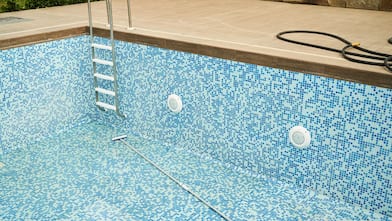Reduce red eyes after swimming
Low pH readings can be troublesome for both swimmers and pool health alike—but how do you raise pH in pools? If your eyes burn after you open them underwater or it looks like grout or plaster is eroding faster than normal, you might have slightly more acidic water than is ideal.
Don't fear—this is something you can troubleshoot and potentially fix yourself. Here's how to raise pH in pools using household items (or a quick trip to the pool store).
Why Should I Raise My Pool's pH?
Your pool's pH level is a measure of how acidic or alkaline the water is. The amount of chlorine in your pool largely dictates the acidity/alkalinity of the water, though other factors can impact the levels, too. Your pool should hover between a range of 7.2 and 7.8 (on the pH scale of 1 to 14).
If your pool's water is low, meaning acidic, you should attempt to raise the levels.
Here's why:
Acidic water can damage your pool liner.
Acidic water may make a swimmer's eyes sting and turn red.
Pool chemicals work less effectively in acidic water.
Bacteria and germ growth may become an issue.
Erosion of grout, stone, or concrete in and around the pool is more likely.
Corrosion on pool fixtures like stairs, railings, and diving boards is also more likely.
For maximum enjoyment of the pool—as well as pool preservation—it's a good idea to get the levels back to within normal range sooner rather than later.
How Much Does It Cost to Raise a Pool's pH?
If you keep up with it, pool maintenance costs shouldn’t break the bank. And if you invest in a liquid pool pH testing kit ($10 to $15) and need to make a trip for an alkaline solution, you may spend up to $40 total to raise your pool's pH.
But you may not even have to pay that much, especially if your pH level isn't that low—in which case you can use baking soda, which you may already have at home.
If, after taking measurements and troubleshooting for a few weeks, it seems like your pool likes to chronically dip low, you may want to invest in a bulk bag of baking soda (sodium bicarbonate), which costs as low as $20 online.
You'll pay a bit more on the front end, perhaps, but save yourself trips to the pool store and save on total price-per-pound as compared to single-use bags.
Signs of Low pH Levels in Swimming Pools

A low pH reading means your pool's water is acidic—not ideal for swimming or for your pool, for that matter. You won't know your pool's pH levels are low without using a testing kit. But there are some signs you can look for.
Signs of low pH in pool water include:
Plaster around the pool wearing down
Stone or tile erosion
Cracks or erosion of grout
Cloudy pool water
Cracked pool liner
Raising a swimming pool's pH can help reverse these issues or slow them down. It's a good idea to tackle the issue as soon as you notice it, and since it only takes an hour or two, you shouldn't have too much of a problem.
If your pool has been neglected or looks to be in serious disarray, it probably makes sense to hire a local pool cleaning and maintenance service—especially if you don't feel equipped to tackle the job yourself.
How to Raise pH in Pools
From testing to ongoing assessment, here's how to get rid of acidic pool water and make your pool more enjoyable to swim in.
1. Use a Test Kit to Measure your Pool's pH
As the saying goes, what gets measured, can be managed. You shouldn't go tinkering with your pool's pH on a whim. Instead, use either a strip or liquid testing kit to get an exact measurement, then troubleshoot from there.
Liquid kits tend to be more accurate and can be used multiple times. It's probably worth investing in one of these, especially if you suspect low pH has been an issue for a while.
2. Clean Your Pool

Besides excessive chlorine in the pool, the number one cause of low pH is debris, such as dirt and leaves, floating on the surface. Skim these out and make sure your filter is clear and running properly before adding anything to neutralize the pH.
Some interesting strategies, like preventing sunscreen buildup on the surface of your pool by dropping a tennis ball in it, can become regular staples of your summer pool cleaning routine.
3. Check That Your Pool's Filter Is Running Properly
Before adding anything to balance out the pH, check your pool's filter and clear out leaves or debris. A properly running (and unclogged) filter will ensure the baking soda or soda ash you add later is properly distributed throughout the pool.
4. Add Baking Soda or Soda Ash
Baking soda and soda ash are two solutions you can add to water to raise a pool's pH. You can add whichever one you choose directly to the pool from the side. For best results, walk around the edge and distribute it evenly.
Add 1.5 pounds of baking soda per 10,000 gallons of water. The average swimming pool holds between 18,000 and 20,000 gallons of water, so you may need up to (or more than) 3 pounds of baking soda. If pH levels are very low (mid-6s or lower), you may want to use soda ash, which can be purchased at a pool store. Read labels to determine how much you should add.
Both baking soda and soda ash may take time to dissolve, making your pool water look cloudy. Avoid adding more until what you've added has been fully integrated.
5. Retest Your Pool's pH Levels

Wait at least 24 hours to measure your pool's pH levels again.
If pool pH levels are improving but still low—and the baking soda/soda ash is clearly dissolved into the water—you can add more and repeat this process until you're back in the normal range. If the number didn't improve at all, try again (perhaps this time using soda ash instead of baking soda).
Retest pool levels two to three times per week to get an accurate reading when trying to raise levels. If you troubleshoot three or more times without results, it's probably time to call in a local pool cleaner who has experience raising low pH levels.
How to Prevent Low pH in Pools
Think about how you'll clean and maintain your pool to keep the pH level in a normal range. Test your levels once a week, and pick the right pool cleaning chemicals for your pool. Chlorine tablets, for example, have been an issue for some homeowners in raising their pool's pH.
Practice proper DIY pool maintenance strategies, like cleaning out filters and skimming your pool regularly, after you've added an alkaline solution to your pool. This, along with regularly testing your levels and adding baking soda/soda ash periodically to keep the pH within range, should help keep the pH levels stable.
Be sure to carefully measure whichever type of chlorine you add at the beginning of the season. After a few seasons of owning and operating a pool, it can feel easy to just eyeball it. But getting the ratio correct from the start is key, especially if you've had a low pH in previous summers. If you add more throughout the summer, follow instructions carefully.
DIY vs. Hire a Pro

Raising a swimming pool's pH levels isn't too challenging, so most homeowners should be able to tackle the job without hiring a pool service to do it.
However, if low pH is just one problem of many with your pool—or if the water or surface surrounding your pool isn't safe to stand or work on, hire a pool repair company near you.
Frequently Asked Questions
Is pool pH important?
Yes. Too high of a pool pH level may result in a rash, red eyes, or stinging eyes for swimmers. It means chlorine isn't as abundant as it needs to be to neutralize germs. Too low of a pH means the water is too acidic and may make swimming less enjoyable.
What is the ideal pH for swimming pools?
Between 7 and 7.6 is an ideal pH for swimming pools, or 80 to 120 parts per million (ppm). Your pool testing kit should be able to measure both these numbers.
Is it safe to swim with a low pH?
It's not ideal, and if your pH level is seriously low (below 7), it's not a good idea to swim until you raise it.
Keep in mind that low pH can be responsible for damaging the pool itself. Acidic water can contribute to the cracking of your pool's liner. Installing a new pool liner may cost up to $2,500, so this is an expensive fix.





